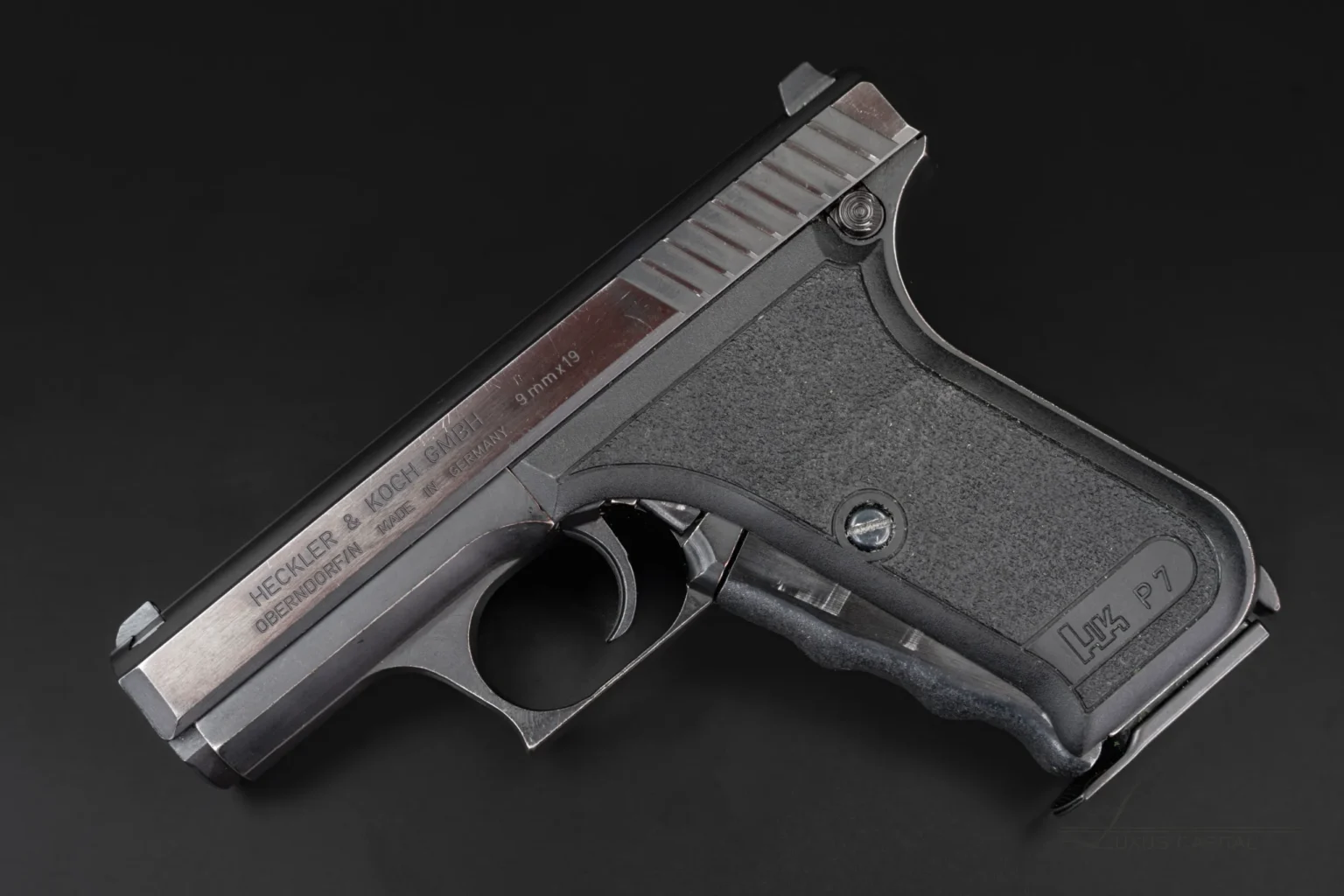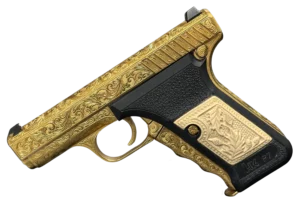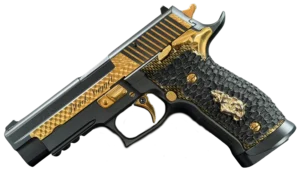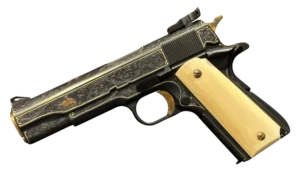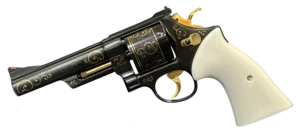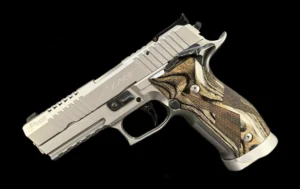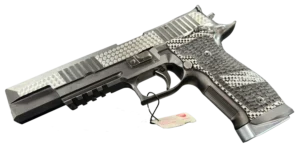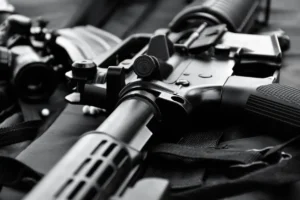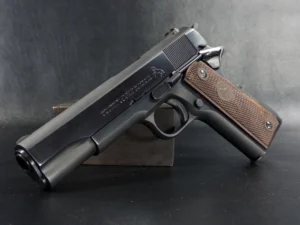Key Takeaways:
- The HK P7 isn’t just different — it’s unapologetically brilliant: From its gas-delayed blowback system to the squeeze cocker grip, the P7 does everything its way. It’s not trying to be trendy or tactical — it’s just built to work, and it does that with weird, elegant precision. Once you understand it, it kinda ruins other pistols for you.
- Shooting a P7 feels like cheating — in the best way: It’s soft, smooth, and scarily accurate. The recoil’s almost polite, the ergonomics make sense, and the fixed barrel means you’re stacking rounds without even trying. It’s the kind of gun that makes average shooters feel dialed in.
- This isn’t just a handgun — it’s a mechanical love letter: The P7 has soul. It’s over-engineered most charmingly, made of solid steel, and feels like it was built to last three lifetimes. You don’t just shoot it — you bond with it. And yeah, once you do, it’s hard to go back to anything else.
Have you ever picked up something — a tool, a book, even a coffee mug — and known it was made with intent? Not mass-produced nonsense, but the kind of thing someone sweated over. The Heckler & Koch P7 is precisely that kind of thing.
It doesn’t scream for attention. No rails, no red dots, no polymer gimmicks. Just a cold steel whisper that says: “I know what I am.”
And, yes, if you’re here, you probably already know the P7 is somewhat of a legend. Or at least you’ve heard the name tossed around in hushed tones by gun nerds, 1980s German cop drama fans, or folks who genuinely appreciate strange but brilliant engineering. Let’s get into it.
A Brief, Weirdly Beautiful History
So, picture this: It’s the 1970s, and the German police need a new sidearm. Their old stuff? Clunky. Unsafe. Not exactly confidence-inspiring during tense moments. Enter Heckler & Koch, known even back then for being a bit obsessive (in the best way) about precision engineering.
Their answer was the P7 — a blowback-operated, squeeze-cocked oddball that looked nothing like what anyone else was doing. And yet… it worked. It worked so well that it quietly slipped into service with German law enforcement and a few other agencies around the world.
Not bad for a gun that doesn’t look like a service pistol at all.
How the P7 Series Evolved
The first model out of the gate was the P7 PSP — PSP standing for “Polizei Selbstlade Pistole,” or “Police Self-Loading Pistol.” Functional name. German efficiency.
But H&K didn’t stop there. They kept tweaking it — sometimes in ways you’d barely notice unless you know what to look for. The P7M8 came next, followed by the double-stack P7M13, and a handful of others, including the compact P7K3.
Each one brought something to the table: better heat shielding here, higher capacity there. Always thoughtful. Always just a little different.
Why the P7 Mattered (and Still Does)
At a glance, the P7 might seem… dated. No optics cut, no threaded barrel, no accessory rail. But that’s the point. This thing was built during a time when people wanted guns that ran, full stop. And the P7 ran — cleanly, consistently, and with a sort of surgical accuracy that made it a darling of not just police departments but also serious shooters and, later, collectors.
It was used in high-risk situations — hostage rescues, counter-terror missions, stuff where second chances aren’t a thing. And the P7 earned a reputation: not flashy, but flawless.
That alone gives it a particular kind of street cred you can’t fake.
The Wild, Wonderful Tech Inside
Okay, buckle up, because this is where things get a little geeky — and honestly, brilliant.
Gas-Delayed Blowback (Wait, What?)
Yeah, you read that right. Instead of the usual locked-breech setup, the P7 uses gas pressure to slow the slide down after firing. There’s a little piston under the barrel that captures some of the expanding gas and resists rearward movement. Sounds complicated? It is.
But the result? Way less recoil. Faster follow-up shots. And that “laser beam” feeling people always talk about when they describe how the P7 shoots.
It’s weird. It’s clever. It works.
Squeeze Cocker — The “Love It or Leave It” Feature
Here’s the thing everyone remembers: the grip. Specifically, the squeeze cocker. You’ve gotta squeeze the frontstrap to cock the striker. Let go, and the gun decocks. No manual safety. No DA/SA nonsense. Just squeeze to go.
Some people hate it. Some swear by it. But once you get used to it, it becomes second nature — and genuinely safer than a lot of other systems, especially in high-stress scenarios.
Fixed Barrel — Built-in Accuracy
Another thing you’ll notice: the barrel doesn’t tilt. It’s pinned directly to the frame. That might not sound like a big deal, but it means zero movement during the firing cycle — and that translates to better accuracy.
It’s part of why the P7 feels so “anchored” when you shoot it. Every shot goes precisely where you want, and nothing wiggles or wanders.
Numbers, Sizes, and Stats (For the Spec Junkies)
Let’s get the boring but necessary stuff out of the way, because if you’re thinking about owning one of these, the specs do matter.
- Overall Length: 6.3” to 6.9”
- Barrel Length: 3.8” to 4.13”
- Height: Around 5”
- Width: 1.1” to 1.3”
- Weight (unloaded): 1.65 to 2.75 lbs
So yeah, it’s compact. Not tiny, but small enough for concealed carry — especially the M8. The all-steel build provides it with enough heft to stay planted without being too heavy to carry.
Calibers: Mostly 9mm, though there were rare versions in .32 ACP, .380 ACP, and .40 S&W. Good luck finding those.
Magazine Capacity: 7 to 13 rounds, depending on the model. The M8? 8+1. The M13? You guessed it — 13+1.
Steel, Through and Through
No polymer here. The P7 is built like a tank, featuring a forged steel frame, a steel slide, and either a blued or nickel finish, depending on the model. That gives it some serious longevity, and honestly, a timeless feel in your hand.
It feels… substantial. It’s not just a tool, but something you’ll pass down.
Shooting the P7: What It Feels Like
First time you shoot one, you’ll probably do a double-take.
The recoil is soft. Mellow. The gun cycles back into place with a weird, almost hydraulic feel. It’s the gas system doing its thing — and it’s addictive.
The grip shape helps, too. It’s comfortable. Ergonomic in a very ’70s-German sort of way. Shoots flat. Tracks straight. The sights aren’t fancy, but they’re precise.
Bottom line? It’s a joy to shoot. Doesn’t matter if you’re a veteran or a first-timer — the P7 makes you look good.
Cleaning and Maintenance: Surprisingly Simple
You’d think something this clever would be a nightmare to maintain, but no. Field-stripping the P7 is straightforward:
- Drop the mag and clear the chamber.
- Hit the takedown lever.
- Slide everything forward and off.
- Pull the recoil spring and guide rod.
- Clean, lube, reassemble. Done.
Just remember to pay extra attention to the gas piston area. It gets filthy. But honestly, a little scrub and it’s fine.
The Variants: A Quick Tour
P7M8
The “classic” one. 8-round mag, heat shield added, slight improvements over the original PSP. If you want a shooter, this is it.
P7M13
Double-stack version with a thicker grip. A bit chunkier, but more rounds. Harder to find — and collectors love ’em.
P7K3
Compact, blowback-operated, usually in .380 ACP. Less common. Not gas-delayed like the others, but still feels like a P7. Excellent for deep carry or small hands.
Limited Editions
Think: engraved slides, special finishes, commemorative runs. Rare, expensive, and borderline art pieces. Not really meant for range days — unless you’re showing off.
So… Why Own a P7?
That’s a fair question. With modern handguns offering optics cuts, light rails, and 15+1 mags in tiny packages… why go vintage?
Because this thing is special.
It’s built differently. It works differently. It asks you to slow down, learn its quirks, and appreciate a kind of mechanical harmony that most modern guns don’t have.
Also? It’s just cool. It’s James Bond cool. German-engineered cool. You pull this thing out at the range, and you will get questions.
The Collector Angle
Prices for P7s — especially the M8 and M13 — have been climbing steadily. They’re no longer being made, and clean examples are becoming scarce.
If you find one? Hold onto it. They’re not just good guns. They’re heirlooms.
Final Thoughts (Or, Why I’m Still Thinking About This Gun)
You don’t just buy a P7 because it’s practical. You buy it because something about it resonates with you. The way it feels. The history. The way the squeeze cocker clicks into place and makes you feel like you’re holding something… different.
Not better, necessarily. Just honest. Intentional. Cool in that understated, well-tailored-suit kind of way.
So yeah, if you’re thinking about getting one, do it. Or at least shoot one. You’ll see.
Frequently Asked Questions
It’s not just one thing — it’s everything. The gas-delayed blowback system, the squeeze cocker, the fixed barrel… none of it is typical. Most modern pistols follow a formula. The P7 rewrote it. And weirdly enough, it works beautifully.
Nope — it’s one of the safest, most innovative features out there. If you’re not squeezing it, the gun can’t fire. Period. It feels odd at first, but give it time, and you’ll wonder why more guns don’t work this way.
Not really. Field-stripping it is simple — maybe even easier than a Glock once you get used to it. The only tricky bit is keeping the gas piston clean. But even that’s just part of the ritual. A little more TLC, sure — but worth it.
Yes, but it’s becoming increasingly complex. Production stopped years ago, and clean examples — especially M8s and M13s — are getting snapped up by collectors. Expect to pay a premium. But if you do land one? You’ll get every penny’s worth.
Absolutely — especially the M8. It’s compact, reliable, and has that unbeatable first-shot readiness thanks to the squeeze cocker. It’s not the lightest or highest-capacity option, but for a carry gun with soul? It’s hard to beat.


